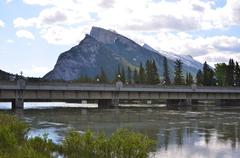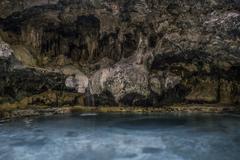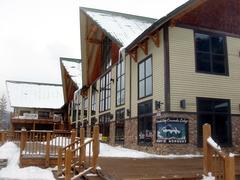Vermilion Lakes Viewpoint Banff Canada: Visiting Hours, Tickets, and Comprehensive Travel Guide
Date: 03/07/2025
Introduction
Vermilion Lakes Viewpoint, located within the heart of Banff National Park in Alberta, Canada, offers visitors a remarkable synthesis of natural splendor, deep-rooted cultural history, and ecological vitality. Situated just west of the Banff townsite, these interconnected shallow lakes are framed by the dramatic silhouettes of Mount Rundle and Mount Norquay, creating postcard-perfect vistas favored by photographers, wildlife enthusiasts, and outdoor adventurers.
Significant for millennia, the area is more than a scenic stop—it has been a cultural gathering place for Indigenous peoples, a corridor for wildlife, and a site of ongoing conservation efforts. This travel guide will provide you with all the essential details for planning your visit, from opening hours and ticketing to accessible activities, nearby attractions, and responsible recreation tips.
Table of Contents
- Introduction
- Visiting Information
- Historical and Cultural Significance
- Geographical and Ecological Features
- Visitor Experience
- Conservation and Environmental Management
- Nearby Attractions and Historical Sites
- Frequently Asked Questions (FAQ)
- Visuals and Media Recommendations
- Plan Your Visit and Stay Connected
- Conclusion
Visiting Information
Visiting Hours and Accessibility
Vermilion Lakes Viewpoint is open year-round, accessible 24/7. While the area itself has no gated entrance, daylight hours—from sunrise to sunset—are best for photography, wildlife viewing, and safety. The 4.3-kilometre Vermilion Lakes Road is accessible by car, bicycle, or on foot. Multiple pullouts and parking areas provide convenience for visitors, including those with mobility challenges. Trails and boardwalks are generally flat, making the area suitable for wheelchairs and strollers (Endless Wonder).
Tickets and Fees
No separate entrance fee is required for Vermilion Lakes; however, a valid Parks Canada pass is necessary for vehicle entry into Banff National Park. Passes can be purchased online or at park entry points (Parks Canada).
Historical and Cultural Significance
Vermilion Lakes bears witness to over 10,800 years of human presence. Archaeological evidence, including prehistoric campsites and tools, aligns with the oral histories of Indigenous nations such as the Stoney Nakoda and Blackfoot. These groups used the lakes and nearby hot springs for hunting, gathering, ceremonies, and healing rituals (Mindful Ecotourism; Bowstrings Banff).
The lakes are part of an ancient corridor, with artifacts on display at the Banff Park Museum National Historic Site. The Stoney Nakoda refer to Banff as “Mînî hrpa” (“Mountain Where The Water Falls”), a testament to the enduring spiritual and cultural meaning of the land (Banff Attractions).
European exploration in the late 19th century led to Banff’s establishment as Canada’s first national park in 1885. Despite new naming conventions and infrastructure, Indigenous cultural heritage remains central to the identity and interpretation of the region (Mindful Ecotourism).
Geographical and Ecological Features
Biodiversity and Wetland Ecosystem
The Vermilion Lakes form a dynamic wetland complex, fed by the Bow River and groundwater springs. This ecosystem supports:
- Birds: Over 200 species, including ospreys, bald eagles, great blue herons, and migratory waterfowl.
- Mammals: Frequent sightings of elk, beavers, muskrats, and occasionally moose. The area is also a crucial corridor for wolves, grizzly bears, and cougars (Rocky Mountain Outlook).
- Amphibians and Fish: Breeding grounds for western toads, salamanders, and native fish like mountain whitefish and bull trout (Banff Science).
Riparian zones, marshes, and sedge meadows stabilize the shoreline, filter water, and sustain diverse food webs.
Hydrological Functions
The wetlands perform critical environmental services:
- Flood Mitigation: Absorbing excess water and reducing downstream flooding.
- Water Quality Regulation: Filtering sediments and pollutants before runoff enters the Bow River.
- Groundwater Recharge: Maintaining aquifer levels through slow percolation of water (Banff Science).
Geologically, the lakes and valley were shaped by glacial activity, and the surrounding limestone and dolomite mountains influence water chemistry and landscape features.
Visitor Experience
Scenic Viewing and Photography
Vermilion Lakes is renowned for its mirror-like reflections of Mount Rundle and vibrant sunsets. Early morning mist and golden-hour lighting offer exceptional opportunities for landscape and wildlife photography (The Banff Blog; Azul Guide).
Wildlife Watching
Wildlife is most active around dawn and dusk. Visitors are encouraged to bring binoculars and telephoto lenses, observe animals from a safe distance, and respect ecological sensitivities (Banff & Lake Louise Tourism).
Outdoor Activities
- Canoeing & Kayaking: Calm, interconnected lakes are perfect for paddling. Rentals are available nearby (The Banff Blog).
- Cycling & Walking: Flat, paved Vermilion Lakes Drive is suitable for bikes, strollers, and wheelchairs (Park Pilgrim).
- Picnicking & Relaxation: Enjoy peaceful meals and mountain views at pullouts along the lakeshore.
- Stargazing: Limited light pollution makes Vermilion Lakes popular for night photography and aurora viewing (The Banff Blog).
- Fishing: Catch-and-release fishing is permitted with a national park license (We’re in the Rockies).
Facilities and Accessibility
- Parking: Multiple pullouts along Vermilion Lakes Road; can fill quickly in peak season (Endless Wonder).
- Restrooms: Pit toilets available; no water fountains or food vendors.
- Accessibility: Boardwalks and paved paths accommodate mobility aids.
Conservation and Environmental Management
Restoration and Stewardship
Efforts led by Parks Canada and conservation groups include:
- Native Vegetation Restoration: Replanting and invasive species control (Banff Science).
- Wildlife Corridor Protection: Maintaining safe passages for large mammals is critical for genetic diversity and ecosystem health (Rocky Mountain Outlook).
- Ongoing Research: Regular monitoring of water quality, wildlife populations, and climate impacts (Banff Science).
Environmental Challenges
Key threats include runoff pollution, tourism pressure, invasive species, and climate change. Responsible visitor behavior—staying on paths, keeping pets leashed, and minimizing waste—is essential to sustaining this fragile ecosystem.
Nearby Attractions and Historical Sites
- Cave and Basin National Historic Site: The birthplace of Canada’s national park system, featuring interpretive exhibits and geothermal springs (Cave and Basin).
- Banff Park Museum National Historic Site: Showcasing natural and cultural history (Banff Park Museum).
- Fenland Trail: Accessible forested loop for walking or cycling (Park Pilgrim).
- Banff Townsite: Offers dining, shopping, and cultural experiences.
- Bow Valley Parkway & Lake Minnewanka: Nearby scenic drives and hiking opportunities.
Frequently Asked Questions (FAQ)
Q: Are there entrance fees?
A: No separate fee for Vermilion Lakes; a valid Banff National Park pass is required.
Q: What are the best visiting hours?
A: Sunrise and sunset provide the best conditions for photography and wildlife viewing.
Q: Is Vermilion Lakes accessible for wheelchairs and strollers?
A: Yes, paved roads, parking, and boardwalks ensure accessibility.
Q: Can I swim in Vermilion Lakes?
A: Swimming is not recommended due to marshy shores and cold water.
Q: Are pets allowed?
A: Yes, but pets must be leashed and under control to protect wildlife.
Q: Is fishing allowed?
A: Yes, with a valid national park fishing license.
Visuals and Media Recommendations
For a more immersive experience, explore photo galleries and virtual tours on Parks Canada’s website. Use images with descriptive alt text such as “Vermilion Lakes sunrise reflection Banff” or “Wildlife at Vermilion Lakes Banff National Park” for optimal search visibility and accessibility.
Plan Your Visit and Stay Connected
- Download the Audiala app for guided tours, maps, and real-time updates.
- Follow official Banff National Park and Audiala channels on social media for the latest news and seasonal tips.
- Check Parks Canada’s Banff National Park page for current conditions, events, and regulations.
Conclusion
Vermilion Lakes Viewpoint stands as a testament to Banff National Park’s harmonious blend of natural beauty, deep cultural roots, and ecological importance. With no additional entrance fees (aside from a park pass), year-round accessibility, and world-class scenery, it is an inviting destination for all. Whether you’re drawn by sunrise reflections, the call of wildlife, or the echoes of ancient traditions, Vermilion Lakes promises a memorable and meaningful connection to the Canadian Rockies.
For a richer visit, explore nearby historical sites and embrace responsible recreation. Download the Audiala app to enhance your experience, and follow us for continued updates and inspiration.
References
- Parks Canada – Vermilion Lakes
- Banff Science – Wetlands Ecosystems
- Endless Wonder – Vermilion Lakes Guide
- Azul Guide – Vermilion Lakes Viewpoint
- Mindful Ecotourism – Indigenous History
- Rocky Mountain Outlook – Wildlife Corridor
- Bowstrings Banff – Indigenous Map Sources
- Banff Attractions – Vermilion Lakes Road
- Banff National Park Official Site
- The Banff Blog – Vermilion Lakes
- Travel Banff Canada – Best Banff Viewpoints
- Banff Park Museum National Historic Site
- Cave and Basin National Historic Site



